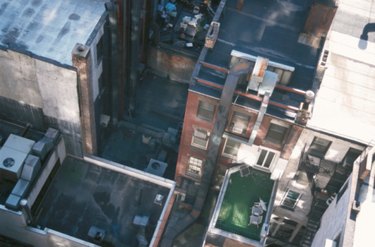Things You'll Need
Scrub brush
Shingles
Chemical roof cleaner
Chlorine-based cleaners (optional)
Spray bottle
20 or 24" pressure washer

Flat roofs are common in many architectural styles for business and residential buildings. While they are as cosmetically viable as slanted roofs and in fact do feature a slight, barely noticeable slant, they have shortcomings that require extra maintenance. Most notably, flat roofs have the tendency to collect water from rain, which can lead to potential issues, such as the buildup of unsightly algae and stains. These stains can be cleaned by a variety of methods.
General Maintenance
Step 1
Remove any standing water from the top of the flat roof. Use a large brush to push away the water and any leaves that have collected on the surface. This is especially important if tall trees extend over the top of the roof as this can lead to many stains.
Video of the Day
Step 2
Protect the soil and plants surrounding your home. If you use any kind of bleach or chlorine solution to wash your roof, this has the potential to contaminate or even kill plant life. Try collecting any water you push from your roof and discard of it properly.
Step 3
Replace shingles as needed. As shingles crack due to heat or chemicals associated with washing, they have the tendency to be hot beds of mold and fungus growth.
Chemical Wash
Step 1
Invest in a roof cleaner to remove stains and growth from your flat roof. Cleaners specifically designed for this purpose, unlike chlorine-based bleaches, better penetrate the shingles to stunt growth without causing dangerous chemical runoff.
Step 2
Use chlorine bleach to spot clean especially troubled areas. Apply a diluted solution of one part bleach to three parts warm water to the area with a spray bottle and scrub as needed with a scrub brush. Use sparingly.
Step 3
Avoid sodium hydroxide-based cleaners for your flat roof. These are not only less effective than other chemical cleaners, they provide a greater potential for damage to your roof.
Pressure Washing
Step 1
Use a 20- or 24-inch pressure washer for this task. An industrial strength washer will have a long wand that will allow you to pressure wash from the safety of the ground below. Otherwise, you will need to stand carefully on the roof or a nearby ladder during washing.
Step 2
Position the spray wand of your pressure washer no more than six inches from the surface of the roof. This will help you control runoff and apply appropriate pressure on the roof.
Step 3
Rinse the cleaned areas throughout the washing process to ensure the area will not dry out or crack, especially on hot, sunny days or if you add a chemical solution to your pressure washer.
Video of the Day